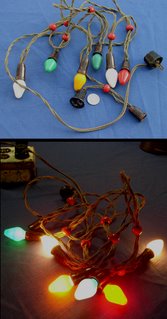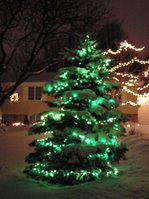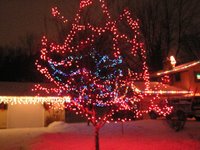Tree-trimming season is upon us, and with it, another round in the storied lightweight bout between two exterior holiday decorating concepts, a veritable clash of aesthetic titans. This intense rivalry between opposing lighting schemes begins to heat up in the Schwister household every year after Thanksgiving. Actually, it's
outside the household---the battle royale of lights is joined in the front yard, its thrilling highs and gut-wrenching lows strung up and lit up for all the neighborhood to see. Wait. . . what's that? Do I hear the ring announcer now?
"To my left, in the Minnesota corner, wearing the tastefully understated white trunks, is the Wayside Warrior: Mary "Gibson Golightly" Schwister! And to my right in the Wisconsin corner, wearing the gaudy, glowing trunks-of-many-colors, is the legendary Wauwatosa Bomber himself, Norman Schwister!"
Before the first round bell, let's take a brief moment to learn about outdoor lighting.
Currently in vogue are those ubiquious strings of tree lights with smallish, white lights---you've seen them: very tasteful, very secular, very timeless. In their purest expression, they shine steadfast and cool, staying solidly in the background. They're modest about their talent and don't make a big deal out of stardom. They're generous tippers and always wait their turn in queue. If they have something to say, they keep it to themselves because, really, they wouldn't
think of imposing. We shall refer to these as Minnesota lights.
Wisconsin lights, on the other hand, had their heyday long ago but dream of a big comeback. They're over-the-hill quarterbacks who've had three beers too many and won't shut up about that Hail Mary touchdown pass back in junior year. They are large, colorful, inefficient, and prone to shorts, bulb breakages, and fires. These garish dinosaurs look a little something like this:

Wisconsin-style "C-bulb" lights were at the cutting edge of outdoor holiday lighting technology in the 1950s and 60s before losing market "wattage" to more energy-efficient white-light models in the 70s and 80s. The white light manufacturers moved their factories just across the river to the lawless Minnesota Territory, where they could produce lights cheaply and in mass quantities by forcing thousands of hapless University of Minnesota English majors to labor in sweatshops (that's okay; they didn't have anything better to do), and the Wisconsin light industry just rolled over and went to sleep. While we'll likely never see those chunky bulbs circulating in great numbers again, exuberant Wisconsin-style lighting aesthetics are undergoing a kind of renaissance lately. Sales of blinky lights, tube lights, and icicle lights are robust. And that's not even getting into those creepy animatronic lighted deer figures.
Back to the fights. In recent years, Norm and Mary's gleeful holiday bouts have mostly ended in split decisions, with the yard on one side of the driveway decorated a la Minnesota, and the other side Wisconsin style. Who can say what will be the result of this year's go-around? Stay tuned. Round one is due to begin shortly.
[Editor's note: The
75 Norm-Herald has dispatched our most highly decorated field reporter to the scene to collect photographs of the 2006 Schwister lighting bout. Images will be posted as soon as they're available.]










